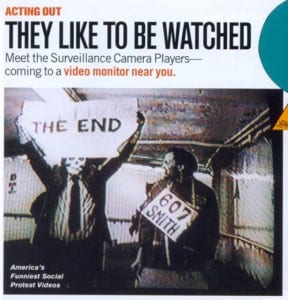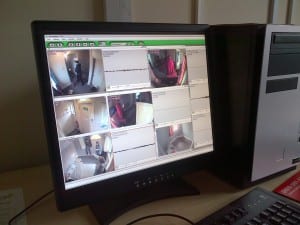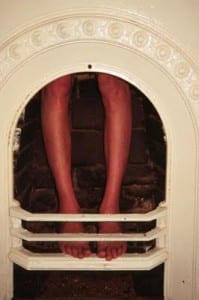During one of our recent sessions we produced a teaser trailer for our piece involving placards, similar to the Surveillance Camera Players and shots revealing each room in the house within thirty seconds. We have decided to produce the snippets regularly to slowly reveal more information for our possible audience, for example the location.
((Surveillance Camera Players (2001) online: http://www.notbored.org/generic.jpg (accessed 20/02/2013)))
“The door is a crossing, a junction marking the divide between the realm of the public and the private” ((Heathcote, Edwin (2012) The Meaning of Home, London: Frances Lincoln p.25)) We have 18 different perspectives of home within our group, most of them will be similar with personal differences. For these short trailers as we don’t have a concrete idea of what each room in the houses final performances will entail we thought about exposing all types of home for different people, what the divide between the public and private is for them. Home for a lot of people is a safe zone, where you feel most comfort and at ease, however this isn’t the case for everyone.
After brainstorming between us one of the performance ideas we had was to show the idea of entrapment, with maybe a couple of performers sitting watching the television and when getting up to go get a drink their hands are tied behind them.
In our last session session we watched some clips of performances. One that stood out to me was Oreet Ashery’s Say Cheese. Seeing this clip shocked me as to how comfortable the ‘audience member’ felt in this situation. When watching at first I assumed they were lifelong friends confiding in each other. While watching this clip it occurred to me we have been devising ideas on making our audience feel vulnerable or uncomfortable rather than at home and safe which is what a home is supposed to feel like. In one of our trailers or for a pre-recording for the piece it would be nice if we could bring a couple people to the house and sit them in the different rooms and ask them what they think of as home and how it makes them feel. There was something special about seeing two strangers really enjoying each other’s company within such a small amount of time, it would be an idea to try to make one of our audience members feel this.
Image: Online: http://www.notbored.org/the-scp.html (accessed 10th Feburary 2013).




